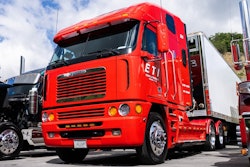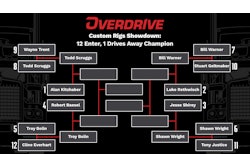Tips For Bobtailing
*Don’t do it unless you have to do it.
*If you have to do it, change your driving habits to meet the challenge immediately upon getting into the truck.
*In slippery conditions cut your speed as far back as possible.
*Shifting cadence will change. Take it easy until you have it figured out.
*Braking distances will increase. Wheels will skip, but even if they don’t, you can lock them up very easily. Locked wheels mean you are out of control.
*Check your seat belt is snug. You’ll need it to stay in the seat.
*Gear selection is a special challenge. Use the clutch.
*At slow speeds on dry pavement, you will experience dramatic deceleration when braking. Be ready for it.
*When getting under your next load, remember to change your mental awareness back to loaded, 13-foot 6-inch, 70-foot head.
Bobtailing. It’s a poetic, graphic word for driving a horse without a wagon, but poetry does not save this mechanical horse from being an exceedingly rough bronc to ride. Anyone over the status of rookie can tell you just how uncomfortable and unstable a bobtail tractor can be. Nevertheless, it is common to see drivers flash by on the Big Road at speeds that would destabilize a loaded truck, let alone a bobtail. Even rain does not slow down some drivers, whose lack of common sense is exceeded only by their ability to get nowhere fast. Few are the drivers who make money without a trailer.

Nevertheless, some fleets do pay their owner-drivers to bobtail. “We’re in a niche market,” says Steve Rumble, general manager of Worldwide Freight Carrier in Mishawaka, Ind. “Our trucks bobtail about 15 percent of the time because we provide power-only services. We try to keep bobtail to a minimum, and most drivers drop their loads and go to a truckstop to wait for dispatch. We have to wait for a load with a trailer, and our customer base is pretty much dedicated, so we sometimes have to dispatch a truck 200 miles to get a load.” Rumble says the bobtail rate is anywhere from 25 to 45 cents per mile depending on the freight they’re dispatched to pick up. Ralph James, who dispatches for Worldwide, says the fleet averaged 87 cents per mile last year for all miles. He notes drivers don’t complain about bobtailing since they’re getting paid for it.
Worldwide has not had a bobtail accident in the two years they have been in business, Rumble says. “Owner-operators carry their own bobtail insurance, and the rates are the same in this operation as in any other,” he says. “We are interested in remaining accident free. We tell our drivers it’s not a race track out there, to keep their speed down and to stay off the roads when the weather is bad.”
According to Lou Markowitz, fleet manager for Crete Carrier’s Eastern Pennsylvania terminal, “Crete’s policy does not allow the use of trucks as personal vehicles. Occasionally a driver will have to bobtail between trailers, but we discourage unauthorized bobtail.”
From the point of view of this experienced fleet manager and ex-driver, “Bobtailing is dangerous. Trucks are not designed to be operated without trailers. It’s a last resort.”
This opinion is seconded by experienced owner-operators like Kurt Stefler, who pulls for Jones Motor. Stefler admits he does not like to bobtail, saying, “It’s too easy to lose control.” The problem, according to Stefler, is the lack of braking. “The only brakes you have that really work when you bobtail are on the steering axle. Where are you going to go when you hit the brakes and there is no traction?”
There is a certain temptation among drivers when bobtailing becomes necessary or simply expedient to enjoy the increased acceleration available. Certainly any bobtail will get to cruising speed more quickly and will be more willing to flatten grades. But the feel-good aspects of the experience are outweighed by the negatives. Stiff suspensions, when not weighted with a trailer, permit drive wheels to bounce more easily when the brakes are applied. In rain or snow the situation becomes even more dangerous. Brakes that will normally grip the road simply slide.
Mike Ryan, a Hollywood stunt driver who races in the STRANA circuit and the Pikes Peak race, puts it this way, “The tail end is light, and the suspension is stiff without a trailer. In races I count on the fact that my brakes will lock up when I apply them. You don’t want that to happen if you’re not on a track.”
It is not only braking that changes when your horse is a little light in the hindquarters. “Because you’re not pulling any weight, your shifting cadence changes,” Ryan says. “I use my truck as a car at shows, and I have to think about how to shift when I drive it that way.”
Professionals know that a bobtail shifts in different and sometimes unaccountable ways. On uphills, you might think the rpm will drop since you are not pulling any weight to drag down the revs. But since it is unusual to shift up on uphills when loaded, doing so bobtailing means rethinking what is happening. In reality rpms will drop more quickly than expected shifting up on uphills. On a downgrade rpms rise quickly as the weight turns the engine faster, and you must slow down your ground speed at the top of the rpm range to find a lower gear. When bobtailing, less weight is dragging down engine speed, but this is compensated for by the fact that you are probably going faster than you would if loaded. So when trying to find a lower gear going downhill, you probably need to rev it up to less than the top of the rpm range to grab that gear. You might consider using the clutch for all shifts to smooth out gear changes when bobtailing.
On level ground, gear floating, or gear selection, becomes a challenge. Slowing down quickly and unexpectedly means finding the right gear to match engine and ground speed, a trickier proposition when unladen.
Cornering requires you to slow down well in advance to avoid brake lockup or skipping wheels, and stop and go traffic requires a thoughtful approach in order to avoid leaving trails of rubber at intersections. In general, slowing down more than a gear means remembering that the lack of weight allows the engine to run more freely, and rpms sag as quickly as they run up when accelerating. Tractors are designed with less sensitive brake pressure when the trailer supply valve is pulled out, meaning that it requires less pedal pressure to apply the same amount of braking pressure at the wheel. Tromping on the brakes in panic mode is bound to cause loss of control at worst. At the very least, using the brakes too boldly will slow you down more quickly than expected at slow speeds on dry pavement and require you to figure out which gear you can select given your ground speed. Gear floating, or skipping gears, requires a deft touch and thought beforehand.
Ryan believes one key to safe bobtailing is to remember immediately upon entering the tractor to change your driving habits to compensate for the new situation. Not doing so immediately means the first few minutes of driving will be more dangerous than they should. Remembering new braking behaviors and gear selection patterns will help in making bobtailing as safe and comfortable as possible.
Lastly, bobtailing means you will eventually have to rein in your horse and get under a trailer. To a certain degree, you must once again remember to return to established patterns. You need to remember trailer off-track and height immediately. Forgetting you are dragging a wagon can be costly. Hooking to your wagon may be a good time to remind yourself of length and height considerations. It is certainly a good time to remind yourself about your trailer in many ways. Take the time to pull under and hook up right. Don’t make the mistake of hitting the king pin without hooking up the air lines. And do a thorough pretrip just to get used to the idea of pulling a load again.
If the experienced owner-operator and the professional stunt driver are right, there is more to bobtailing than meets the eye. And that is precisely the point. It can be fun, but it can also be dangerous because it is very different than the normal driving situation.








